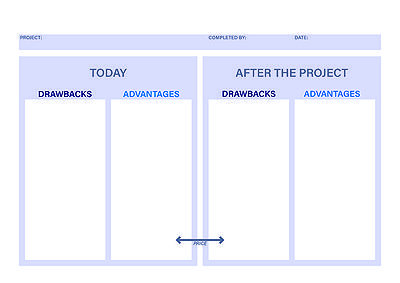Resistance to Change Mapping
Projects related to change are almost inevitable to receive resistance from some of the people who will be affected by the change [1]. Dent and Goldberg [2] argues that people don't resist the change itself but the unknown. To accommodate the resistance, it’s important to shed light on the uncertainties the affected employees might have and the project manager's rationale behind the changes [3]. To enhance the employees’ readiness for change and thereby reduce their resistance project managers must help to make sense of the changing situation Cite error: Invalid <ref> tag;
refs with no content must have a name.
Resistance to Change Mapping is a tool which can help to facilitate communication between the stakeholders with low influence and high interest, and the project managers and owners to involve the people affected by the change Cite error: Invalid <ref> tag;
refs with no content must have a name.
The purpose of this article is to introduce the tool ‘Resistance to Change Mapping’ as a change management tool to assess various stakeholders’ oppositions. The objective is to create a space for stakeholders to address their concerns and give rise to project managers to make initiatives to accommodate the drawbacks and uncertainties related to the change. Thus, reducing the resistance and increasing the likelihood of the project's success Cite error: Invalid <ref> tag;
refs with no content must have a name.
Contents |
The Big idea
Introduction
Resistance to change
Resistance to change is a natural part of the change process, and different logical reasons why organizational members don’t necessarily show their support from the beginning exist (Conner, 1992). From a change management perspective, it's important to understand these behaviours and the reasons behind them, thus take actions to accommodate the organizational members' concerns and take actions to increase their support for the change (Kreye, 2020).
Kotter and Schlesinger (2008) have identified four main reasons why organizational members show resistance to change including low trust, low tolerance for change, different assessment, and parochial self-interest. Misunderstandings and different views on situations are reoccurring themes behind these reasons (Kotter and Schlesinger, 2008).
- Future work: More theory about why organizational members tend to show resistance to change.
Resistance to Change Mapping is a tool which can help to get the reasons behind the resistance to change out in the upon and make the price of the change clear (Olsson et al., 2018).
Resistance to Change Mapping
Resistance to Change Mapping is a tool to get stakeholders to express their doubts and resistance to change. Additionally, it clarifies the price for the change (Olsson et al., 2018). By utilizing the tool change managers can optimize their communication towards the stakeholders by getting a better understanding of how each individual or group respond to the proposed change (Olsson).
When changes are being implemented the project managers tend to focus on the drawbacks of the current situation, and the advantages of the future situation. Stakeholders with low influence and high interest, on the other hand, are more focused on the advantages of how it is now, and the drawbacks related to the change (Olsson et al., 2018).
Resistance to Change Mapping is divided into the situation today and after the implementation, and further into drawbacks and advantages for each category. The affected stakeholders and project managers shall in collaboration outline their thoughts for each section to create a shared understanding. The project managers shall use the output to accommodate the identified drawbacks related to the change, and improve their communication outwardly (Olsson et al., 2018).
- Future work: What does the output show, and how should project managers use this information?
Application
It's important to involve the right people when utilizing the tool since the output is only as good as the team doing the assessment. If the project managers don't have a good understanding of the stakeholders involved it would be beneficial to do a process mapping and a stakeholder analysis.
When the team has been identified, and they are meeting to conduct the tool it’s essential to create an open environment where all kind of feedback is welcome. The project managers should listen without defending their project or neglecting the concerns the stakeholders express (Olsson et al., 2018).
- Future work: How might change managers create an open environment
- Future work: Example
Limitations
Every tool has its limitations including Resistance to Change Mapping. Some of the limitations are, as mentioned earlier, that the output is only as good as the team utilizing it. If stakeholders with low influence but whose tasks are being affected by the change, don't become involved and hence becomes resistant to the unknown, the change is less likely to succeed (Olsson et al., 2018). Additionally, the tool does not provide any specific actions for the project managers to implement or a communication strategy. It only helps to give a better understanding of the unspoken uncertainties and misgivings the stakeholders might have.
References
- ↑ Olsson, J.R., Ahrengot, N. and Attrup, M.L. (2018) Power I Projekter og Portfølje. Viborg: Djøf Forlag.
- ↑ Dent, E.B. and Goldberg, S.G. (1999) “Challenging ‘resistance to change,’” The Journal of Applied Behavioral Science, 35(1), pp. 25–41. Available at: https://doi.org/10.1177/0021886399351003.
- ↑ Kreye, M.E. (2020) “Reading material 42543 - Management of Change.” Kongens Lyngby: Technical University of Denmark.
Conner, D.R. (1992) Managing at the speed of change: How to prosper in an uncertain world.
Dent, E.B. and Goldberg, S.G. (1999) “Challenging ‘resistance to change,’” The Journal of Applied Behavioral Science, 35(1), pp. 25–41. Available at: https://doi.org/10.1177/0021886399351003.
Kreye, M.E. (2020) “Reading material 42543 - Management of Change.” Kongens Lyngby: Technical University of Denmark.
Olsson, J.R. (no date) Det dobbelte bogholderi, airborn leadership. Available at: https://airbornleadership.com/tool/det-dobbelte-bogholderi/ (Accessed: February 11, 2023).
Olsson, J.R., Ahrengot, N. and Attrup, M.L. (2018) Power I Projekter og Portfølje. Viborg: Djøf Forlag. - The tool doesn’t provide initiatives to accommodate the concerns
